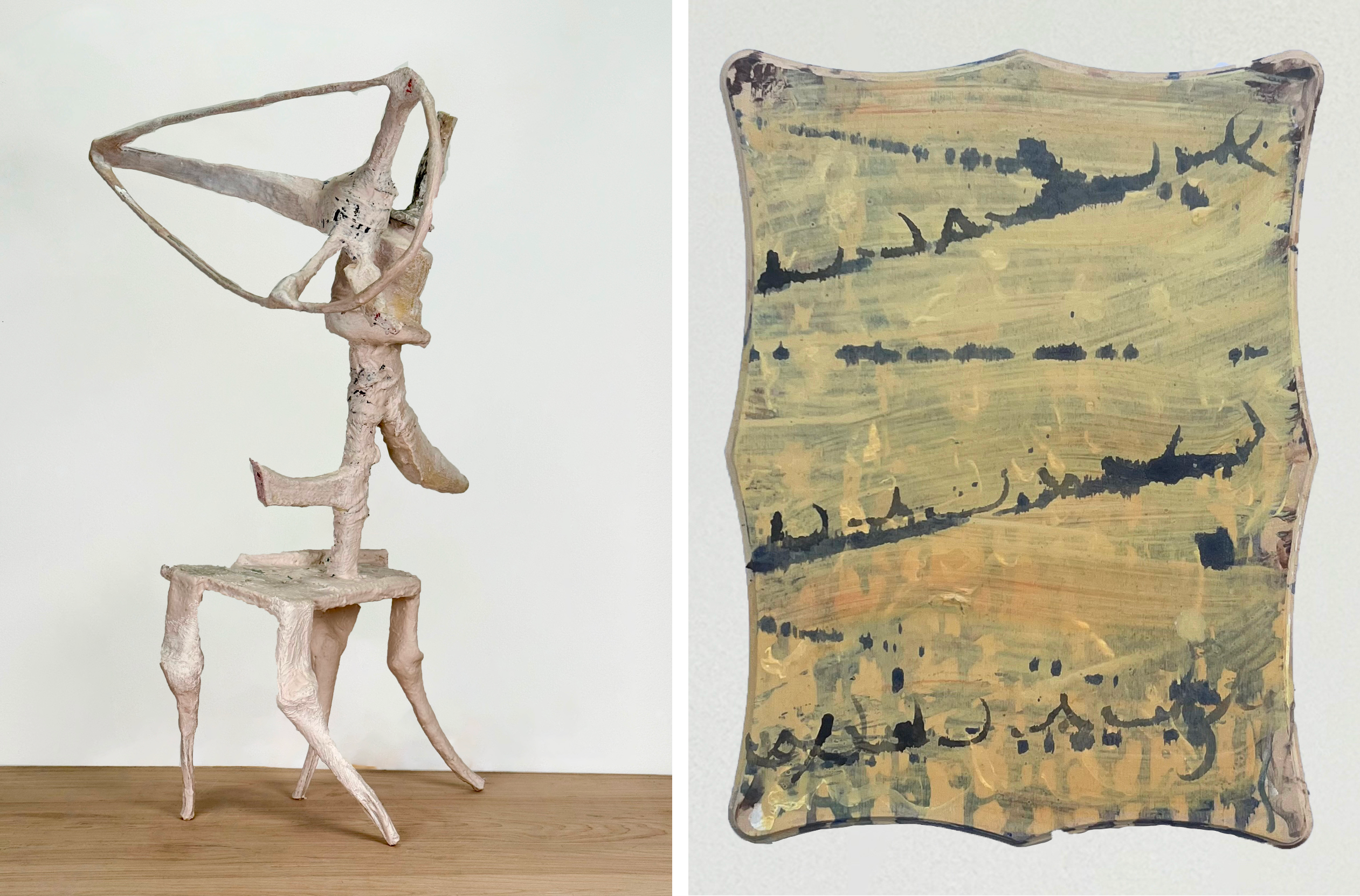The Exhibition
A dialogue of paintings by Peter Acheson with sculptures by Gret Sterrett Smith.

Singing in Unison, Part 9, in collaboration with SLAG&RX, is presenting a selection of paintings by Peter Acheson in dialogue with sculptures by Gret Sterrett Smith.
Both artists are products of countercultural movements that reject American jingoism and consumerism, and have shared a lifelong interest in the Jungian theory of the collective unconscious, considering alchemy’s dual nature—the chemical and mystical—which has shaped their lives. Though they each have deeply contemplated in different ways the visionary lineage that can be traced back to the works of Carl Jung, Albert Pinkham Ryder, Robert Duncan, Jess, Diane di Prima, James Hillman, Michael Heizer, Gillian Jagger, Martin Puryear to Ron Gorchov, Ursula von Rydingsvard, and Bill Jensen, both Acheson and Smith yield a similar affinity in respect to their pictorial processes.

While Acheson came to artistic maturity while working in New York City, Smith’s roots are in San Francisco. Though they share a mutual disregard for the traditional boundaries of artmaking, and a similar comparable preference for fluid migration and the inseparability of forms and materials, they do so in different ways. Acheson insists on an iterative practice that constantly lays the groundwork for the transmutation of legible images, abstract emblems, inscriptions, and asemic writings, among other unnamable mark-makings in his configurations. Smith, on the other hand, effortlessly creates provisional constructions, bringing disparate elements together three-dimensionally only to accentuate their precarious forms in relation to gravity and visual paradoxes.
Despite Acheson’s two-dimensional pictorial conception of his work, the aura of his deployment of materials often achieves three-dimensional substance. Likewise, Smith thinks through form in her sculptures using the two-dimensional framework of collage. This visual dialogue between Acheson and Smith therefore posits their mediations of alchemical processes as a revelation of the wondrous affinities between the transcendent nature of their psyches, and their visceral and individual approaches to artmaking.

Hours and location
April 11–May 18, 2024
Opening: April 11, 6–8
Location:
SLAG&RX
522 W 19th St, New York
view map
Admission:
The exhibition is free and open to the public
Hours:
Tuesday–Saturday, 10–6
Artists
Peter Acheson received his BFA from Yale in 1976. An early member of the Williamsburg art scene of the 1980s, Acheson relocated to upstate New York where he has worked since the 90s. Acheson utilizes an array of found materials discovered around his upstate studio—including animal bones and petrified wood—alongside acrylic and oil on canvas and wooden panels.
Gret Sterrett Smith studied painting at Goddard College with James Gahagan, and graduated with a BFA in painting in 1980 from the San Francisco Art Institute, where she studied with Hassel Smith, Franklin Williams, Robert Hudson, and Angela Davis, and was part of the group of artists and poets in Jess and Robert Duncan’s household and Diane di Prima’s circle. She moved to New York in 1993 and has been painting, drawing, and making sculptures ever since.
About Singing in Unison
Since May 2022, Rail Curatorial Projects has undertaken an ongoing series of group exhibitions entitled “Singing in Unison: Artists Need to Create on the Same Scale That Society Has the Capacity to Destroy” as a collective effort to mobilize the art of joining and social intimacy against self-isolation and social distancing, In these exhibitions, we perceive each artist as the player of a particular instrument, having a unique and distinct sound of their own, producing a significant contribution to the total sound of the symphony.
The series has featured works made by both trained and self-taught artists, by young artists—including children from the legendary Studio in a School—and more established ones. Additionally, there are contributions from artists working during and after incarceration, as well as those who are living with various mental health conditions. Although the culture at large has frequently aimed to assimilate us all into having a similar sound, Rail Curatorial Projects is committed to celebrating each artist’s particular vibrancy, while at the same time providing a context in which they can be in dialogue with one another.
To date, eight iterations of varying sizes have been presented in this series of exhibitions, featuring a total of over 200 artists across seven venues: Art Cake, Below Grand, The Scully Tomasko Foundation, Ricco/Maresca Gallery, TOTAH, Miguel Abreu Gallery, and Industry City. Each version featured Lauren Bon and Metabolic Studio’s neon work Artists Need to Create on the Same Scale That Society Has the Capacity to Destroy; cooking performances by Rirkrit Tiravanija, Tomas Vu, and their graduate students from Columbia University; space activations, including performances from dancers, poets, and musicians; and each has been dedicated to and included a portrait of one of our recently deceased mentors and friends. The early exhibitions in the series all included several artists, and we have now also begun to feature two artists in conversation: when presented in this more intimate context, the similarities and differences in the artists’ practices highlight alluring and compelling aspects of their thinking and art-making processes.
About the Brooklyn Rail
Founded in October 2000 and currently published 10 times annually, the Brooklyn Rail provides an independent forum for arts, culture, and politics throughout New York City and far beyond. The journal features criticism of music, dance, film, and theater; and original fiction and poetry, covers contemporary visual art in particular depth. In order to democratize our art coverage, our Critics Page functions with a rotating editorship, which such luminaries as Robert Storr, Elizabeth Baker, Barbara Rose, Irving Sandler, and Dore Ashton have helmed.
The Rail further fulfills its mission by curating art exhibitions, panel discussions, reading series and film screenings that reflect the complexity and inventiveness of the city’s artistic and cultural landscape.
To learn more, visit brooklynrail.org
Follow us on Instagram instagram.com/brooklynrail
